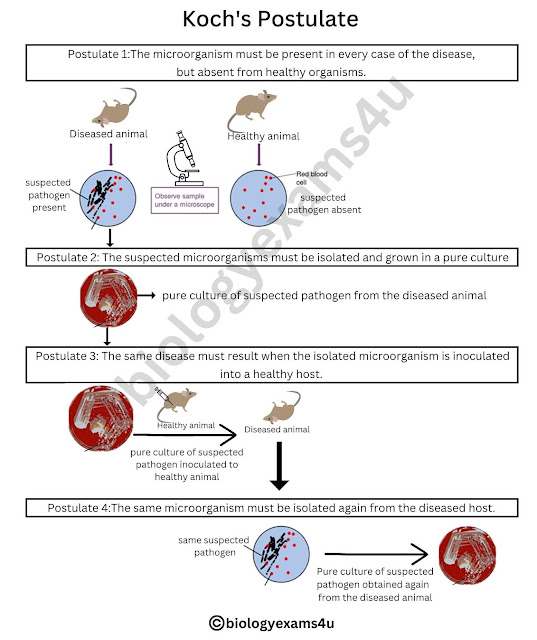Koch's Postulates vs Molecular Koch's Postulates
Koch's postulates are a set of criteria used to establish a causal
relationship between a microorganism and a disease.
Postulate 1. The microorganism must be present in every case
of the disease but absent from healthy organisms.
Koch's Experiment:
- Koch developed a staining technique to examine human tissue.
- Mycobacterium tuberculosis cells could be identified in diseased tissue.
Postulate 2. The microorganism must be isolated from the
diseased host and grown in pure culture.
Koch's Experiment:
Koch grew M. tuberculosis in pure culture on coagulated blood
serum.
Postulate 3. The same disease must result when the
isolated microorganism is inoculated into a healthy host.
Koch's Experiment:
- Koch injected cells from the pure culture of M.tuberculosis into guinea pigs.
- The guinea pigs subsequently died of tuberculosis
Postulate 4. The
microorganism must be re-isolated from the inoculated, diseased individual and
matched to the original microorganism.
Koch's Experiment:
Koch isolated M. tuberculosis from the dead guinea pigs and was able to
again culture the microbe in pure culture on coagulated blood serum.
Understand More: 9 Exceptions to Koch’s postulate
Molecular Koch's Postulates
In 1988, Stanley Falkow proposed a revised form of Koch’s postulates
known as molecular Koch’s postulates using genetic tools. He revised Koch’s
postulate incorporating the advancement in the field of microbiology, molecular
biology, recombinant DNA technology etc.
Molecular Koch's postulates are used to determine what genes contribute
to a pathogen's ability to cause disease.
Postulate 1. The phenotype (sign or symptom of disease) should be associated only
with pathogenic strains of a species.
Falkow’s
modifications to Koch’s original postulates explain not only infections caused
by intracellular pathogens such as viruses but also the existence of pathogenic
strains of organisms that are usually non-pathogenic.
Explanation:
Escherichia coli is a member of the normal microbiota of the human intestine and is
generally considered harmless.
Pathogenic strains enterohaemorrhagic E. coli (EHEC): exist because of the acquisition of new
genes by the once-harmless E. coli, is now capable of producing
toxins and causing illness.
Postulate 2. Inactivation of the suspected gene(s) associated with pathogenicity
should result in a measurable loss of pathogenicity
Explanation:
Pathogenic strains enterohaemorrhagic E. coli (EHEC): One of the genes
in EHEC encodes for Shiga toxin, a bacterial toxin (poison) that inhibits
protein synthesis. Inactivating this gene reduces the bacteria’s ability to
cause disease
Postulate 3. Reversion of the inactive gene should restore the disease phenotype
Explanation:
Pathogenic strains enterohaemorrhagic E. coli (EHEC): By adding the gene
that encodes the toxin back into the genome (e.g., with a phage or plasmid),
EHEC’s ability to cause disease is restored.
Limitation of Molecular Koch's postulates
Genetic manipulation of some pathogens is not possible using current
methods of molecular genetics
A great way to thank and support us.
- Visit our TPT store for Koch's Postulate Worksheet
- Download free resources or purchase some.
- Please rate the product and follow us on store.
Thank you so much

.jpg)
Post a Comment
We Love to hear from U :) Leave us a Comment to improve this site
Thanks for Visiting.....